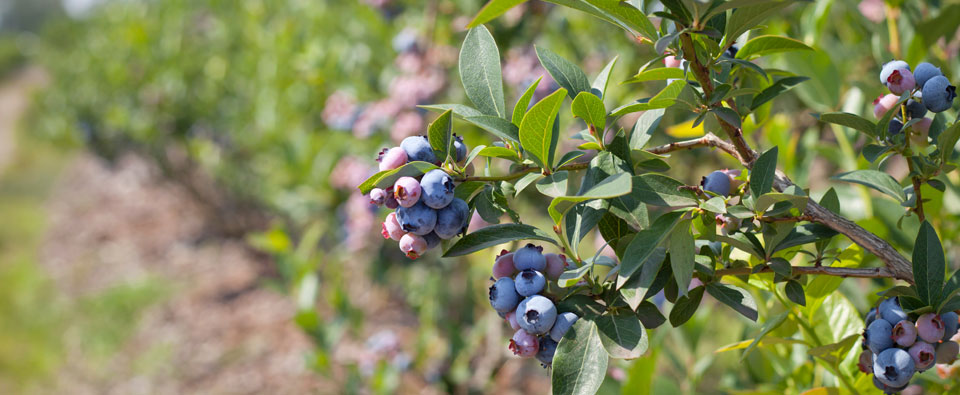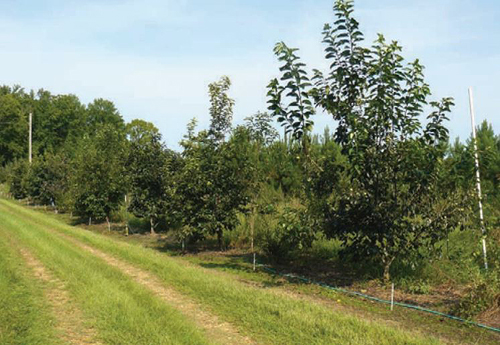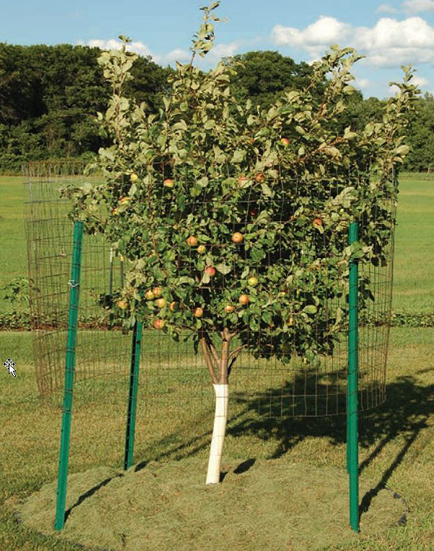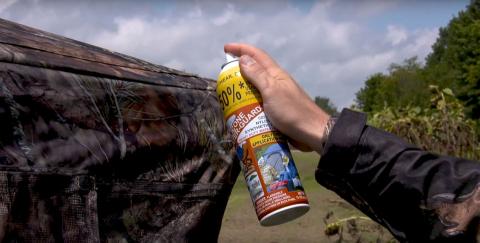Dudley Phelps | Originally published in GameKeepers: Farming for Wildlife Magazine

It’s a given that part of being a gamekeeper usually involves the planting and or management of hard and soft mast plants on your recreational property. We’ve discussed these topics in numerous articles in the past and will continue to do so. But considering most of you enjoy getting your hands dirty regardless of whether or not you are at the hunting camp, we thought it would be cool to change things up a bit and cover a slightly different approach to raising nut and fruit plants. These plants bring big benefits for you, your land and your targeted wildlife.
The subject of “orcharding” has become a hot topic recently, probably due to a plethora of things, but I’d say it’s all loosely tied to (how do I say this in a P.C. way?) our population’s “uncertainty” of our present “system.” Because of this uncertainty, many folks, including myself, have decided to try their hand at practicing to varying degrees, a more sustainable way of living. Some may view it as more primitive, but it is certainly tried and proven.
That doesn’t mean I now ride a horse and buggy to work every day, or don a loin-cloth and chase whitetails around the woods with a spear. But it does mean that me, and many other Americans are growing bigger gardens, and in addition are learning how to use grandmother’s mason jars for things other than sweet tea receptacles. Others may be raising their own eggs or purchasing them from a neighbor down the street instead of at the grocery store. The fact of the matter is, more and more people in today’s society are becoming increasingly interested in learning how to supplement their lifestyle (or income) so as to rely less and less on outside sources.
The level of preparedness is totally up to the person, but I’d like to think most gamekeepers are either already practicing or are at least interested to some degree in farming for themselves in the same way we enjoy farming for wildlife.
How Orcharding Benefits Your Land
So if you are already adding plants and trees to benefit wildlife at your farm, or are planning on getting started in the future, why not go ahead and plant something that can benefit your family and friends while you are at it? Fresh fruits and vegetables are much better for you and much less expensive than those found in stores.
Depending on the species and where they are planted, many species can also benefit your targeted wildlife species and serve dual purposes. For example, apple trees can be used for feeding and attracting deer as well as filling your freezer and cupboard with pies, jellies, sauce, juice, or cider. The wildly popular chestnuts or pecans can be used for filling your tag, while at the same time can be used to sell for profit, feed yourself, or fatten up some livestock.

short electric fence to fend off marauding possums and raccoons.
My point is there’s no rule stating fruit and nut producers have to be planted on the back side of a distant food plot an hour drive away at the hunting club and a 30-minute walk from the cabin. In fact, it may be easier to grow, manage, harvest, and process the “fruits of your labor” around the clubhouse, or at your own home.
In the Yard: Pretty and Practical Mast Plants
We all have different scenarios at the homestead, but if you have room to plant a few ornamentals, then you have room to plant something you can eat. Most, if not all of the time, fruit and nut trees can be just as “ornamental” in comparison to standard yard plants and trees. Take for example pearslike their ornamental cousins, they provide a showy display in the form of blooms every spring, but in addition give you tasty morsels of fruity goodness each summer and fall. Pears don’t have to be eaten right away, they can be stored and snacked on for a short period before being quartered or sliced, sauced or juiced, and either frozen, dried, or canned.
Plums and figs are two more perfect additions to a yardscape with ornamental qualities. They can be eaten fresh out of hand or canned in various ways to be enjoyed the rest of the year. What about blueberries? They can be grown just about anywhere the soil is acidic and make for a super hedge to plant around the edge of the yard. Just this past July, my family and I visited a friend who transformed an empty lot next door into a multi-variety blueberry orchard. We gladly paid the small fee to collect several gallons of fruits to add to our freezer for use in cereal, smoothies, jams, and cobblers. Based on the crowd of folks picking away with us, I’d say she’s doing quite well with her side venture.
Home Away from Home: Orcharding at the Cabin
The cabin away from home also makes for a great, easy to maintain and harvest area for raising fruit and nut crops. Although it may be a seasonal or weekend retreat, your cabin offers amenities similar to your home that you don’t have access to in a distant food plot. The most important positive that comes to mind is you’ll probably have running water and the ability to more easily irrigate your trees when needed. If you are as stubborn about unnecessary visits to your food plots during the fall and winter as I am, you’ll also appreciate the fact you can pick the cabin area’s harvest between hunts without fear of educating your target bucks.

protected even if they’re in your backyard.
So what type of fruits and nuts are a better choice for the cabin orchard? Like any other planting scenario, it largely depends on your soils and climate. But aside from a growth and survival standpoint, you may need to consider how often you get to visit the cabin, and how much time you want to spend keeping diseases and pests at bay. I don’t know about you, but when I get a precious spring or summer weekend day to chase turkeys, put out BioLogic BioRocks, mow the clover plots, or move cameras around, I may not have time to spray for bugs and diseases on the fruit trees around the cabin. For these reasons my choice is to go with fruit and nut species or cultivars that are more adept at fending for themselves, have a wider range of maturity and ripening, or keep well either on the tree or on the ground. Mulberries, Asian persimmons, scab-resistant pecans, blight-resistant pears, muscadine grapes, and the most disease-resistant apples and crabs come to mind, but there are plenty more options.
The Fun Factor
Like all of the complex work a gamekeeper does involved with putting meat on the table, raising your own produce from fruit and nut trees can be a heck of a lot of fun and rewarding for you and your family. Fruit plants, mast plants and nut species are a great way to engage kids about the art of sustainable food production. It will also provide something to bring home from a hunting trip when the wild game doesn’t cooperate. If you are interested in getting started, this fall through next spring are perfect times to get a few fruit and nut trees in the ground. As always, if you need some pointers about what varieties may be best for your area — the folks at Nativ Nurseries are always happy to help. Keep in mind that it may be wise to get your tree orders in early during these uncertain times. Just like guns and ammo, fruit and nut trees are in great demand these days.






























